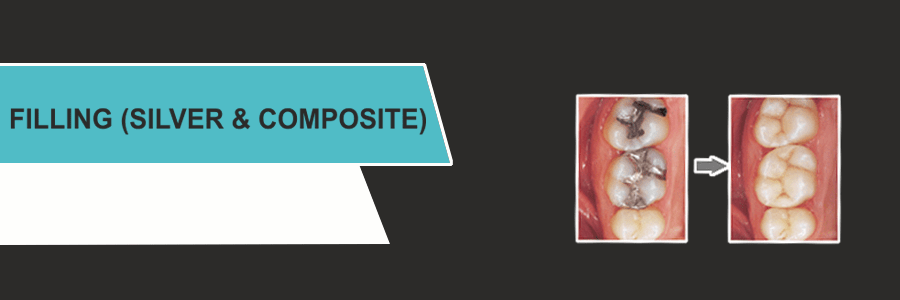
What is teeth filling?
A teeth filing is a way to restore a tooth damaged by decay back to its normal function and shape. When a dentist gives you a filling, he or she first removes the decayed tooth material, cleans the affected area, and then fills the cleaned out cavity the with a filling material.
By closing off spaces where bacteria can enter, a filling also helps prevent further decay. Materials used for fillings include gold, porcelain, a composite resin (tooth-colored fillings), and an amalgam (an alloy of mercury, silver, copper, tin and sometimes zinc).
Silver Fillings (Amalgams)
Advantages of silver fillings:
- Durability — silver fillings last at least 10 to 15 years and usually outlasts composite (tooth-colored) fillings.
- Strength — can withstand chewing forces
- Expense — may be less expensive than composite fillings
Disadvantages of silver fillings:
- Poor aesthetics — silver fillings don’t match the color of natural teeth.
- Destruction of more tooth structure — healthy parts of the tooth must often be removed to make a space large enough to hold the amalgam filling.
- Discoloration — amalgam fillings can create a grayish hue to the surrounding tooth structure.
- Cracks and fractures — although all teeth expand and contract in the presence of hot and cold liquids, which ultimately can cause the tooth to crack or fracture, amalgam material — in comparison with other filling materials — may experience a wider degree of expansion and contraction and lead to a higher incidence of cracks and
- Allergic reactions — a small percentage of people, approximately 1%, are allergic to the mercury present in amalgam restorations.
Tooth-colored Composites
Advantages of composites:
- Aesthetics — the shade/color of the composite fillings can be closely matched to the color of existing teeth. Composites are particularly well suited for use in front teeth or visible parts of teeth.
- Bonding to tooth structure — composite fillings actually chemically bond to tooth structure, providing further support.
- Versatility — in addition to use as a filling material for decay, composite fillings can also be used to repair chipped, broken, or worn teeth.
- Tooth-sparing preparation — sometimes less tooth structure needs to be removed compared with amalgam fillings when removing decay and preparing for the filling.
Disadvantages of composites:
- Lack of durability — composite fillings wear out sooner than amalgam fillings (lasting at least five years compared with at least 10 to 15 for amalgams); in addition, they may not last as long as amalgam fillings under the pressure of chewing and particularly if used for large cavities.
- Increased chair time — because of the process to apply the composite material, these fillings can take up to 20 minutes longer than amalgam fillings to place.
- Additional visits — if composites are used for inlays or onlays, more than one office visit may be required.
- Chipping — depending on location, composite materials can chip off the tooth.
- Expense — composite fillings can cost up to twice the cost of amalgam fillings.
In addition to tooth-colored, composite resin fillings, two other tooth-colored fillings exist — ceramics and glass ionomer.
What Happens When You get a Filling?
If your dentist decides to fill a cavity, he or she will first remove the decay and clean the affected area. The cleaned-out cavity will then be filled with any of the variety of materials described above.
How Do I Know if I Need a Filling?
Only your dentist can detect whether you have a cavity that needs to be filled. During a checkup, the dentist will use a small mirror to examine the surfaces of each tooth.
Anything that looks abnormal will then be closely checked with special instruments. Your dentist may also X-ray your entire mouth or a section of it. The type of treatment your dentist chooses will depend on the extent of damage caused by decay.
